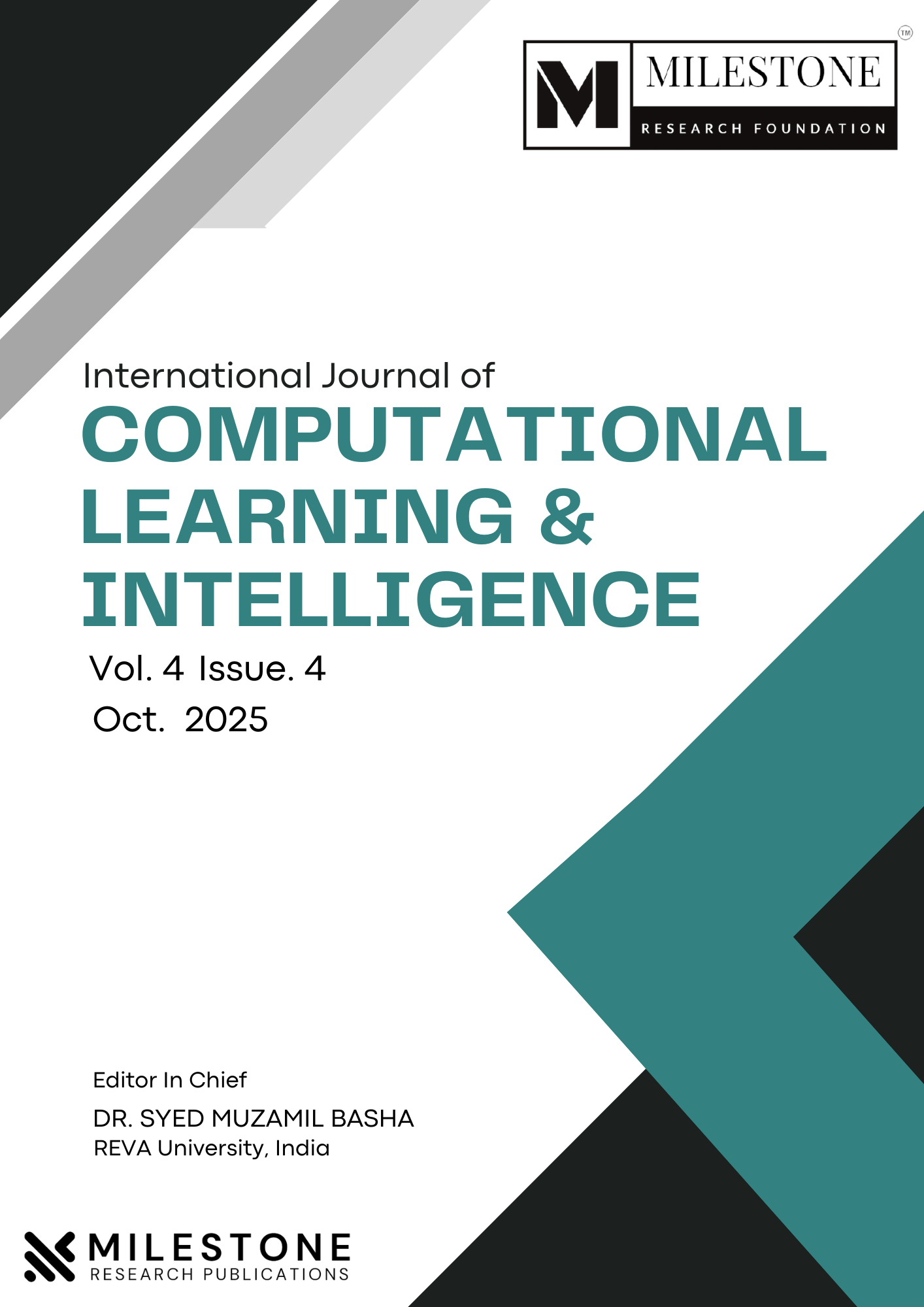Zero Fatality Roads: Leveraging Deep and Transfer Learning on CCD for Automated Crash Detection
Published 2025-06-11
Keywords
- Road Accident Detection,
- Deep Learning,
- Transfer Learning,
- Synthetic Data,
- Convolutional Neural Networks (CNNs)
- EfficientNetB1,
- MobileNetV2,
- Smart Transportation ...More
How to Cite
Copyright (c) 2025 G Ramasubba Reddy, Sunil Jinkathoti, I Sravani, S Nareshkumar Reddy, M Prathap

This work is licensed under a Creative Commons Attribution-NonCommercial-NoDerivatives 4.0 International License.
Abstract
Over a million people have died in road accidents every year, making them one of the world's top sources of injury and death. Human error and delayed incident response are major contributors to road deaths, even with improvements in vehicle design and road infrastructure. This study proposes a robust deep-learning framework for automated road accident detection by harnessing the synergy of transfer learning and car crash data. Addressing the limitations of scarce annotated accident imagery, we employed a publicly available Kaggle dataset called the Car Crash Dataset (CCD), which contains real dashcam videos of traffic accidents, mostly collected from YouTube, to train and evaluate state-of-the-art convolutional neural network models. Using ImageNet-pretrained architectures such as MobileNetV2, VGG19, ResNet50, and EfficientNetB7, we adapted the classification layers for binary classification while leveraging their pre-learned visual features. Our experimental results show that ResNet50 achieved the highest detection performance, with a precision of 97.83%, a recall of 98.78%, an F1-score of 98.05%, and an MCC of 0.955, outperforming the other models. MobileNetV2 also demonstrated strong results, with a precision of 92.84%, a recall of 94.60%, an F1-score of 93.71%, and an MCC of 0.781, making it suitable for deployment in resource-constrained environments. EfficientNetB7 and VGG19 performed moderately but lagged behind ResNet50 and MobileNetV2 in accuracy and correlation measures. This comparison offers essential guidance for choosing CNN architectures that balance accuracy and efficiency for real-time applications.
References
- Sacco, M. A., Saverio, G., Chara, S., Tarallo, A. P., & Isabella, A. (2025). The contribution of forensic medical investigations in road accident deaths. Cureus, 17(3).
- Khalil, R. A., Safelnasr, Z., Yemane, N., Kedir, M., Shafiqur-Rahman, A., & Saeed, N. (2024). Advanced learning technologies for intelligent transportation systems: Prospects and challenges. IEEE Open Journal of Vehicular Technology.
- Lee, G. H., & Han, J. (2025). An edge-based intelligent IoT control system: Achieving energy efficiency with secure real-time incident detection. Journal of Network and Systems Management, 33(1), 1–29.
- Torbaghan, M. E., Sasidharan, M., Reardon, L., & Muchanga-Hvelplund, L. C. (2022). Understanding the potential of emerging digital technologies for improving road safety. Accident Analysis & Prevention, 166, 106543.
- Arefin, M. S., Mahin, M. I. S., & Mily, F. A. (2025). Real-time rapid accident detection for optimizing road safety in Bangladesh. Heliyon.
- El Moussaoui, T., Karim, A., Loqman, C., & Boumhidi, J. (2025). RTACompensator: Leveraging AraBERT and XGBoost for automated road accident compensation. Applied System Innovation, 8(1), 19.
- Kumar, H. R., Raju, K., Prasad, M. G., Chandrappa, S., Ramakrishna, B., & Kumar, B. S. (2025). A novel approach to automatic road-accident detection using deep mutual learning based technique. In Hybrid and Advanced Technologies (pp. 565–570). CRC Press.
- Kumar, N., Sood, S. K., & Saini, M. (2025). IoV-fog-assisted framework for accident detection and classification. ACM Transactions on Embedded Computing Systems, 24(3), 1–19.
- Zimmer, W., Greer, R., Zhou, X., Song, R., Pavel, M., Lehmberg, D., Ghita, A., Gopalkrishnan, A., Trivedi, M., & Knoll, A. (2025). Enhancing highway safety: Accident detection on the A9 test stretch using roadside sensors. arXiv preprint arXiv:2502.00402.
- Chowdhury, S., Barua, S., Banik, S., Naimuddin, K., & Sajib, I. H. (2025). Computer vision-based road accident classification from traffic surveillance.
- Adewopo, V. A., & Elsayed, N. (2024). Smart city transportation: Deep learning ensemble approach for traffic accident detection. IEEE Access.
- Jaspin, K., Bright, A. A., & Legin, M. (2024). Accident detection and severity classification system using YOLO model. In 2024 3rd International Conference on Applied Artificial Intelligence and Computing (ICAAIC) (pp. 1160–1167). IEEE.
- Zahid, A., Qasim, T., Bhatti, N., & Zia, M. (2024). A data-driven approach for road accident detection in surveillance videos. Multimedia Tools and Applications, 83(6), 17217–17231.
- Nusari, A. N. M., Ozbek, I. Y., & Oral, E. A. (2024). Automatic vehicle accident detection and classification from images: A comparison of YOLOv9 and YOLO-NAS algorithms. In 2024 32nd Signal Processing and Communications Applications Conference (SIU) (pp. 1–4). IEEE.
- Ahmed, S. T., Basha, S. M., Ramachandran, M., Daneshmand, M., & Gandomi, A. H. (2023). An edge-AI-enabled autonomous connected ambulance-route resource recommendation protocol (ACA-R3) for eHealth in smart cities. IEEE Internet of Things Journal, 10(13), 11497-11506.
- Ahmed, S. T., Kumar, V. V., & Jeong, J. (2024). Heterogeneous workload-based consumer resource recommendation model for smart cities: EHealth edge–cloud connectivity using federated split learning. IEEE Transactions on Consumer Electronics, 70(1), 4187-4196.
- Ahmed, S. T., Sreedhar Kumar, S., Anusha, B., Bhumika, P., Gunashree, M., & Ishwarya, B. (2020). A generalized study on data mining and clustering algorithms. In New Trends in Computational Vision and Bio-inspired Computing: Selected works presented at the ICCVBIC 2018, Coimbatore, India (pp. 1121-1129). Cham: Springer International Publishing.
- Ahmed, S. T., Basha, S. M., Arumugam, S. R., & Kodabagi, M. M. (2021). Pattern Recognition: An Introduction. MileStone Research Publications.
- Fathima, A. S., Prakesh, D., & Kumari, S. (2022). Defined Circle Friend Recommendation Policy for Growing Social Media. International Journal of Human Computations & Intelligence, 1(1), 9-12.

